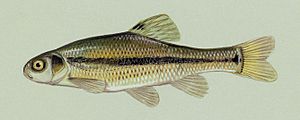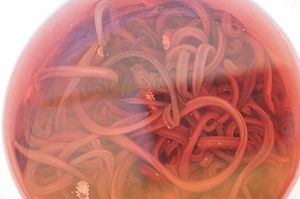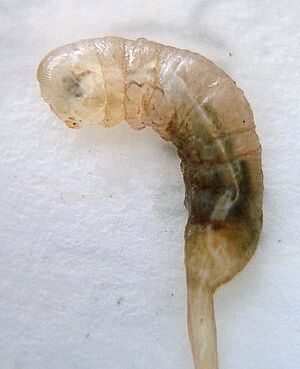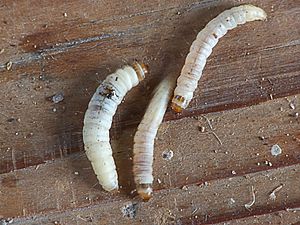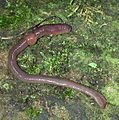Fishing bait facts for kids
Fishing bait is anything used to attract and catch fish. You can put bait on a fishing hook or inside a fish trap. For a long time, people have used things like nightcrawlers, insects, worms, and small bait fish. Today, fishermen also use plastic bait and even electronic lures to get fish interested.
Scientists have found that natural baits, like croaker fish and shrimp, are often recognized more easily by fish. This means fish are more likely to bite them. The type of bait a fisherman chooses usually depends on the kind of fish they want to catch and where those fish live. Fishing bait can be split into two main groups: artificial baits and natural baits.
Artificial Baits
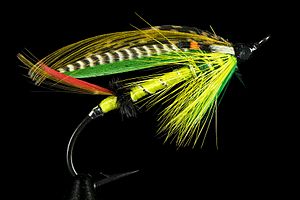
Using lures is a popular way to catch fish that hunt other fish. Lures are fake baits made to look and move like small fish or other prey. Sometimes, you need to move the lure in a special way to make it look even more tempting. For example, in fly fishing, you cast a lightweight lure that looks like an insect. A common way to fish with a soft plastic worm is called the Texas rig.
Natural Baits
When using natural bait, anglers usually pick something that the fish they want to catch would normally eat. This natural bait can be alive or dead. Some common natural baits include worms, leeches (like the bait-leech Nephelopsis obscura), small minnows, frogs, salamanders, and insects. Natural baits work well because they feel, smell, and look like real food to the fish. Even cheese has been known to be a good bait because of its strong smell and bright colors!
Worms for Fishing
The common earthworm is a very popular bait for catching fish in freshwater. Small grubs and maggots are also excellent for catching trout. Other insects like grasshoppers, bees, and even ants are used for trout fishing when they are in season. However, many anglers believe that fish roe (fish eggs) from trout or salmon is even better than any other bait. In warmer places like Florida, USA, fish such as bream will even eat bread bait. Bread bait is just a small piece of bread, often softened with water, rolled into a tiny ball that a small fish can easily eat.
Most common earthworm species, like Lumbricus terrestris (which you can often dig up in your garden), are great for freshwater fishing. But for selling worms, they aren't ideal for worm farming. These greyish-brown earthworms dig deep and don't breed easily in the shallow bins of a worm farm.
Red compost worms, like the well-known red wiggler or the European nightcrawler, are much better for worm farms. They are epigeic, meaning they live closer to the surface. This is why red worms are usually sold commercially as bait worms. They naturally live just under rotting leaves, in compost piles, and other plant litter. They are called detritivorous because they eat detritus (dead organic material).
The larger European nightcrawler is highly sought after for fishing bait. It can handle water that is almost freezing and is one of the few earthworms that can be used for saltwater fishing. These worms can grow up to 7 inches (18 cm) long, but they are usually between 3 and 4 inches (7–10 cm) long. Worm farmers also offer other types of worms for bait, depending on what's available and the weather conditions.
Images for kids
-
A bait fish (weather loach)
-
Crayfish are often sold and used as bait, either alive or just their tail meat. They are good for attracting channel catfish, largemouth bass, pike, and muskellunge.


